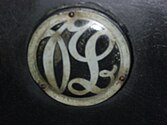Slaby ringers
| SB-Automobil-Gesellschaft mbH
|
|
|---|---|
| legal form | Company with limited liability |
| founding | 1919 |
| resolution | 1924 |
| Reason for dissolution | bankruptcy |
| Seat | Berlin - Charlottenburg , Germany |
| management |
|
| Branch | Automobile manufacturer |
Slaby-Beringer was a German manufacturer of cars, especially electric cars, who produced in Berlin-Charlottenburg from 1919 to 1924 .
history
Rudolf Slaby , born in Berlin in 1887, was the son of Professor Adolf Slaby , lecturer at the Technical University of Charlottenburg and co-founder of Telefunken . Rudolf Slaby began his career in the German aircraft industry. After the Peace Treaty of Versailles , aircraft construction was banned in Germany and Rudolf Slaby had to turn to other activities.
He received his doctorate in 1919 from the TH Hannover as Dr.-Ing. and in the same year founded the company SB-Automobil-Gesellschaft mbH with his cousin Hermann Beringer for the production of small electric cars . Production initially started in Berlin-Charlottenburg in the former Sophienstrasse 19-22 near today's TU Berlin .
Rudolf Slaby designed a small one-person car powered by an electric motor. This revolutionary development had a self-supporting body made of triplex plastic and was specially designed for war invalids , but who usually did not have the necessary money for a vehicle.
Jørgen Skafte Rasmussen , owner of Zschopauer Motorenwerke , which manufactured two-stroke motorcycles for the DKW brand, met Rudolf Slaby in Berlin in the summer of 1919, who was traveling in the small electric car. Rasmussen was enthusiastic and immediately gave Slaby an order for a hundred of the wagons called Slaby-Beringer , which he offered at the Leipzig trade fair. The weight was 180 kg including batteries.
Hermann Beringer later convinced his cousin to build a two-seater that was powered by a DKW engine. From 1920 onwards, 200 self-service cars were sold to Japan , which was the main market for electric vehicles in the following period. There the cars were mostly ordered by state authorities and taxi companies. The Japan and German Electric Cyclecar Co. Osaka was founded as a Japanese partner company and published its own company magazine.
Due to inflation, the company, which was dependent on guarantees, was financially poor despite the exotic export business. After a devastating earthquake in Japan in 1923 , which fell victim to a large shipment of vehicles and the Japanese importer, business with Japan collapsed.
Rasmussen continued to support the company financially and now the production of small cars with DKW petrol engines started. But this did not help much and in June 1924 the SB-Automobil-Gesellschaft had to file for bankruptcy. A total of 2005 self-service cars were built, 266 of them with DKW engines. On September 1, 1924, the production facility in Berlin was shut down.
In order not to lose his investments, Rasmussen took over the remains of the company from the bankruptcy estate and added them to his group as JS Rasmussen AG, Berlin branch . Rudolf Slaby became a designer and technical director in Rasmussen's company and created the first DKW automobile in 1927/28. The DKW P 15 PS with a two-cylinder two - stroke motorcycle engine that had been converted to water cooling had a self-supporting body made of plywood .
Web links and sources
- The shoulders on which we stand. 125 years of TU Berlin: Adolf Slaby (1849–1913) ( Memento from January 5, 2013 in the web archive archive.today )
- http://www.die-besten.de/wartburg/history/marken/marken.htm
- http://www.austroclassic.com/dkw/
- http://www.autogeschiedenis.com/auto/duits/slaby-beringer.htm
- Interesting photos of the small electric cars
Individual evidence
- ↑ https://www.gtue-oldtimerservice.de/automobil/marke/SB%2C+SLABY-BERINGER/781/
- ↑ solarmobil.net (accessed on 8 April 2012)


